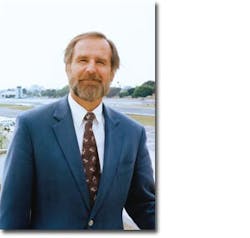The Hawthorne Experiment
HAWTHORNE, CA — Million Air general manager Bruce McCall retired at 52 from his career in corporate marketing with companies like Dr. Pepper and Cadbury Schweppes. Then he learned to fly. One day he recognized that he could work at the airport, at a fixed base operation, and live aviation on a daily basis. He fits with Hawthorne Municipal Airport, which itself is undergoing a redirection via a revitalization effort that he is overseeing. All this became possible because voters overwhelmingly approved a referendum to keep the property as an airport in lieu of shopping malls and the like; and, because of the interest from two developers who will write checks for up to $12 million for airfield development. For historians, it’s also an opportunity to ensure a future for an airport with a past — it is the home of Jack Northrop and his famous ‘Flying Wing’.
Today, Northrop-Grumman remains the major tenant. It is the only other refueling tenant, under a grandfather clause, and it remains an R&D facility. The company has its own leasehold with the City of Hawthorne, outside the 45-year agreement it has with property developers Kearny Real Estate and Wedgewood Enterprise Corporation. Following the recent revamp of the runway and associated pavement, Northrup-Grumman was able to re-base its Gulfstream IV at Hawthorne Municipal, also called Jack Northrop Airport, according to Hilarey K. Benda, director of sales and marketing for Million Air.
Earlier this decade, the city was taking a serious look at offering the airport property for commercial development. Meanwhile, relates Wedgewood president Dave Wehrly, Kearney made its airport redevelopment proposal. The city decided to ask the voters to decide. According to McCall, the airport won out by more than 70 percent.
Explains Wehrly, “Our partner, Kearny Real Estate, negotiated a very unique deal with the military to refurbish the Air Force Base in El Segundo, whereby they received government land in return for upgrading existing buildings and building new offices on the site; it has no airfield.
“In that process they got to know the city leaders of El Segundo and Hawthorne and built a trusting relationship.
“We got involved because we had a King Air based at the airport and couldn’t find anyone who could get a hangar built for us. So we followed the string; that got us to the city, and they introduced us to Kearny.
“They figured having a ground lease on the airport would give them a leg up on acquiring 90 acres south of the airport, which was their primary motivation and which was then owned by Vought Industries. They subsequently got it and we are partners.”
Since that time, the Century Aviation FBO was purchased by the new partners and franchised as Million Air/Los Angeles — to get it on the map, says Wehrly. “We call it Los Angeles Executive at HHR.”
The Kearny-Wedgewood partnership has a 45-year agreement with the city, focused on delivering a balanced general aviation airport that has tenants to meet the need of any aircraft up to a mid-size business jet, explains McCall. “The total game plan is to create the kind of infrastructure that a viable, small reliever airport would have. That means hangar space; the FBO services you’d expect; having a small engine repair shop, as Security Aviation is; that means having a large engine repair shop; it means having an avionics shop, and possibly an interior shop. We’re in hot pursuit to bring those to the field.”
Wehrly explains that the agreement with the city calls for his group to guarantee that the city would receive the same level of revenue it was getting at the time of the changeover, plus 3 percent CPI. The investors get a 10 percent return on invested capital, up to $12 million, when revenue from new development begins. Once the investors recapture their capital investment, the investors and city split the profits 75/25.
Despite the downturn of GA in 2008, Wehrly remains upbeat about his investment. “We are still bullish; they’re not making any more airports in the L.A. basin,” he says.
McCall reinforces the notion: “My focus is to build hangars.” In the L.A. region, hangar space is in high demand, he says. In all some 40 hangars are projected to be built; Phase 1, now underway, calls for nine hangars [seven 45x40-foot and two 65x60-foot] to be completed by October.
